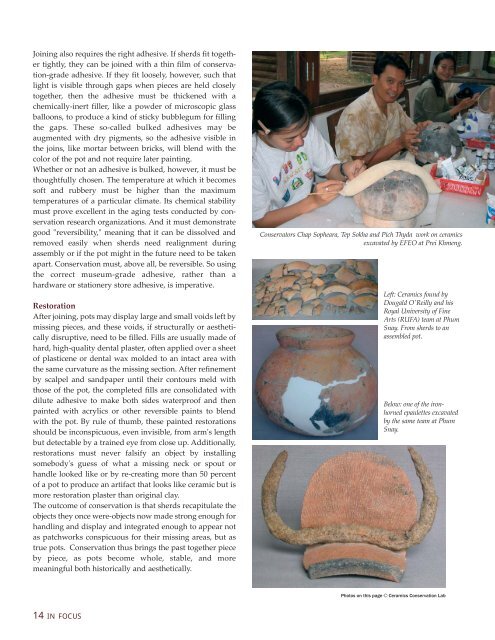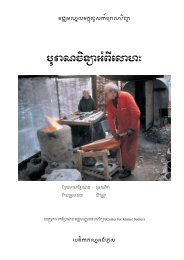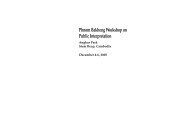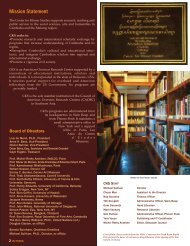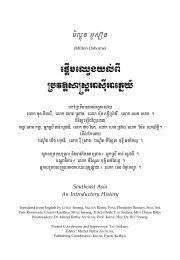In focus 2005-2006.qxd - Center for Khmer Studies
In focus 2005-2006.qxd - Center for Khmer Studies
In focus 2005-2006.qxd - Center for Khmer Studies
Create successful ePaper yourself
Turn your PDF publications into a flip-book with our unique Google optimized e-Paper software.
Joining also requires the right adhesive. If sherds fit together<br />
tightly, they can be joined with a thin film of conservation-grade<br />
adhesive. If they fit loosely, however, such that<br />
light is visible through gaps when pieces are held closely<br />
together, then the adhesive must be thickened with a<br />
chemically-inert filler, like a powder of microscopic glass<br />
balloons, to produce a kind of sticky bubblegum <strong>for</strong> filling<br />
the gaps. These so-called bulked adhesives may be<br />
augmented with dry pigments, so the adhesive visible in<br />
the joins, like mortar between bricks, will blend with the<br />
color of the pot and not require later painting.<br />
Whether or not an adhesive is bulked, however, it must be<br />
thoughtfully chosen. The temperature at which it becomes<br />
soft and rubbery must be higher than the maximum<br />
temperatures of a particular climate. Its chemical stability<br />
must prove excellent in the aging tests conducted by conservation<br />
research organizations. And it must demonstrate<br />
good "reversibility," meaning that it can be dissolved and<br />
removed easily when sherds need realignment during<br />
assembly or if the pot might in the future need to be taken<br />
apart. Conservation must, above all, be reversible. So using<br />
the correct museum-grade adhesive, rather than a<br />
hardware or stationery store adhesive, is imperative.<br />
Restoration<br />
After joining, pots may display large and small voids left by<br />
missing pieces, and these voids, if structurally or aesthetically<br />
disruptive, need to be filled. Fills are usually made of<br />
hard, high-quality dental plaster, often applied over a sheet<br />
of plasticene or dental wax molded to an intact area with<br />
the same curvature as the missing section. After refinement<br />
by scalpel and sandpaper until their contours meld with<br />
those of the pot, the completed fills are consolidated with<br />
dilute adhesive to make both sides waterproof and then<br />
painted with acrylics or other reversible paints to blend<br />
with the pot. By rule of thumb, these painted restorations<br />
should be inconspicuous, even invisible, from arm's length<br />
but detectable by a trained eye from close up. Additionally,<br />
restorations must never falsify an object by installing<br />
somebody's guess of what a missing neck or spout or<br />
handle looked like or by re-creating more than 50 percent<br />
of a pot to produce an artifact that looks like ceramic but is<br />
more restoration plaster than original clay.<br />
The outcome of conservation is that sherds recapitulate the<br />
objects they once were-objects now made strong enough <strong>for</strong><br />
handling and display and integrated enough to appear not<br />
as patchworks conspicuous <strong>for</strong> their missing areas, but as<br />
true pots. Conservation thus brings the past together piece<br />
by piece, as pots become whole, stable, and more<br />
meaningful both historically and aesthetically.<br />
Conservators Chap Sopheara, Tep Sokha and Pich Thyda work on ceramics<br />
excavated by EFEO at Prei Khmeng.<br />
Left: Ceramics found by<br />
Dougald O'Reilly and his<br />
Royal University of Fine<br />
Arts (RUFA) team at Phum<br />
Snay. From sherds to an<br />
assembled pot.<br />
Below: one of the ironhorned<br />
epaulettes excavated<br />
by the same team at Phum<br />
Snay.<br />
Photos on this page © Ceramics Conservation Lab<br />
14 IN FOCUS


